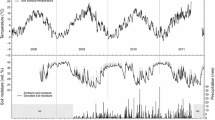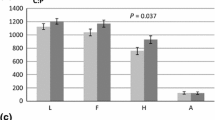Abstract
We studied the effects of atmospheric CO2 enrichment (280, 420 and 560 μl CO2 l−1) and increased N deposition (0,30 and 90 kg ha−1 year−1) on the spruce-forest understory species Oxalis acetosella, Homogyne alpina and Rubus hirtus. Clones of these species formed the ground cover in nine 0.7 m2 model ecosystems with 5-year-old Picea abies trees (leaf area index of approx 2.2). Communities grew on natural forest soil in a simulated montane climate. Independently of N deposition, the rate of light-saturated net photosynthesis of leaves grown and measured at 420 μl CO2 l−1 was higher in Oxalis and in Homogyne, but was not significantly different in Rubus compared to leaves grown and measured at the pre-industrial CO2 concentration of 280 μl l−1. Remarkably, further CO2 enrichment to 560 μl l−1 caused no additional increase of CO2 uptake. With increasing CO2 supply concentrations of non-structural carbohydrates in leaves increased and N concentrations decreased in all species, whereas N deposition had no significant effect on these traits. Above-ground biomass and leaf area production were not significantly affected by elevated CO2 in the more vigorously growing species O. acetosella and R. hirtus, but the “slow growing” H. alpina produced almost twice as much biomass and 50% more leaf area per plant under 420 μl CO2 l−1 compared to 280 μl l−1 (again no further stimulation at 560 μl l−1). In contrast, increased N addition stimulated growth in Oxalis and Rubus but had no effect on Homogyne. In Oxalis (only) biomass per plant was positively correlated with microhabitat quantum flux density at low CO2, but not at high CO2 indicating carbon saturation. On the other hand, the less shade-tolerant Homogyne profited from CO2 enrichment at all understory light levels facilitating its spread into more shady micro-habitats under elevated CO2. These species-specific responses to CO2 and N deposition will affect community structure. The non-linear responses to elevated CO2 of several of the traits studied here suggest that the largest responses to rising atmospheric CO2 are under way now or have already occurred and possible future responses to further increases in CO2 concentration are likely to be much smaller in these understory species.
Similar content being viewed by others
References
Anderson RC, Loucks OL (1973) Aspects of the biology of Trientalis borealis Raf. Ecology 54:798–808
Bazzaz FA (1990) Response of natural ecosystems to the rising global CO2 level. Annu Rev Ecol Syst 21:167–196
Bazzaz FA, Miao SL (1993) Successional status, seed size and responses of tree seedlings to CO2, light and nutrients. Ecology 74:104–112
Erisman JN, Heij GJ (1991) Concentration and deposition of acidifying compounds. In: Heij GJ, Schneider T (eds) Acidification research in the Netherlands. Studies in Environmental Science 46. Elsevier, Amsterdam, pp 51–96
Falkengren-Grerup U (1986) Soil acidification and vegetation changes in deciduous forest in southern Sweden. Oecologia 70:339–347
Farquhar GD, Von Caemmerer S, Berry JA (1980) A biochemical model of photosynthetic CO2 assimilation in leaves of C3 species. Planta 149:78–90
Flückiger W, Braun S (1994) Waldschaden-Bericht, Untersuchungen in Buchenbeobachtungsflächen 1984–1993. Rep Inst Angew Pflanzenbiol, Schönenbuch, Switzerland
Hättenschwiler S, Körner C (1995) Responses to recent climate warming of Pinus sylvestris and Pinus cembra within their montane transition zone in the Swiss Alps. J Veg Sci 6:357–368
Hofmann G, Heinsdorf D, Krauss HH (1990) Wirkung atmogener Stickstoffeinträge auf Produktivität und Stabilität von Kiefern-Forstökosystemen. Beitr Forstwirtsch 24:59–73
Körner C, Arnone JA III (1992) Responses to elevated carbon dioxide in artificial tropical ecosystems. Science 257:1672–1675
Körner C, Miglietta F (1994) Long term effects of naturally elevated CO2 on mediterranean grassland and forest trees. Oecologia 99:343–351
Körner C, Pelaez-Riedl S, Van Bel AJE (1995) CO2 responsiveness of plants: a possible link to phloem loading. Plant Cell Environ 18:595–600
Kriedemann PE, Wong SC (1984) Growth response and photosynthetic acclimation to CO2: comparitive behaviour in two C3 crop species. Acta Hort 162:113–120
Kuhn N, Amiet R, Hufschmid N (1987) Veränderungen in der Waldvegetation der Schweiz infolge Nährstoffanreicherung aus der Atmosphäre. Allg Forst-Jagdztg 156:77–84
Long SP, Drake BG (1992) Photosynthetic CO2 assimilation and rising atmospheric CO2 concentrations. In: Baker NR, Thomas H (eds) Crop photosynthesis: spatial and temporal determinants. Elsevier, Amsterdam, pp 69–101
Luxmoore RJ (1991) A source-sink framework for coupling water, carbon and nutrient dynamics of vegetation. Tree Physiol 9:267–280
Nys C (1989) Fertilisation, dépérissement et production de l'épicéa commun (Picea abies) dans les Ardennes. Rev For Fr 41:336–347
Pearcy RW, Björkman O (1983) Physiological effects. In: Lemon ER (ed) CO2 and Plants. The response of plants to rising levels of atmospheric carbon dioxide. Westview Press, Boulder, pp 65–105
Pitelka LF, Stanton DS, Peckenham MO (1980) Effects of light and density on resource allocation in a forest herb, Aster acuminatus (Compositae). Am J Bot 67:942–948
Sage RF, Sharkey TD, Seemann JR (1989) Acclimation of photosynthesis to elevated CO2 in five C3 species. Plant Physiol 89:590–596
Schulze W, Stitt M, Schulze ED, Neuhaus HE, Fichtner K (1991) A quantification of the significance of assimilatory starch for growth of Arabidopsis thaliana L. Heynh. Plant Physiol 95:890–895
Sharkey TD (1985) Photosynthesis in intact leaves of C3 plants: physics, physiology and rate limitations. Bot Rev 51:54–105
Stitt M (1991) Rising CO2 levels and their potential significance for carbon flow in photosynthetic cells. Plant Cell Environ 14:741–762
Tamm CO (1972) Survival and flowering of some perennial herbs. III. The behaviour of Primula veris on permanent plots. Oikos 23:159–166
Thimonier A, Dupouey JL, Timbal J (1992) Floristic changes in the herb-layer vegetation of a deciduous forest in the Lorraine Plain under the influence of atmospheric deposition. For Ecol Manage 55:149–167
Valle R, Mishoe JW, Campbell WJ, Jones JW, Allen LH Jr (1985) Photosynthetic responses of “bragg” soybean leaves adapted to different CO2 environments. Crop Sci 25:333–339
Van Breemen N, Dijk HFG van (1988) Ecosystem effects of deposition of nitrogen in the Netherlands. Environ Pollut 54:249–274
Webber AN, Nie G-Y, Long SP (1994) Acclimation of photosynthetic proteins to rising atmospheric CO2. Photosynth Res 39:413–425
Wong SC (1990) Elevated atmospherical partial pressure of CO2 and plant growth. II. Non-structural carbohydrate content in cotton plants and its effect on growth parameters. Photosynth Res 23:171–180
Wong SC, Dunin FX (1987) Photosynthesis and transpiration of trees in a eucalypt forest stand: CO2, light and humidity responses. Aust J Plant Physiol 14:619–632
Author information
Authors and Affiliations
Rights and permissions
About this article
Cite this article
Hättenschwiler, S., Körner, C. Effects of elevated CO2 and increased nitrogen deposition on photosynthesis and growth of understory plants in spruce model ecosystems. Oecologia 106, 172–180 (1996). https://doi.org/10.1007/BF00328596
Received:
Accepted:
Issue Date:
DOI: https://doi.org/10.1007/BF00328596




